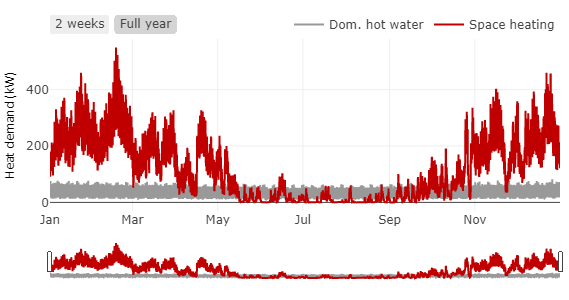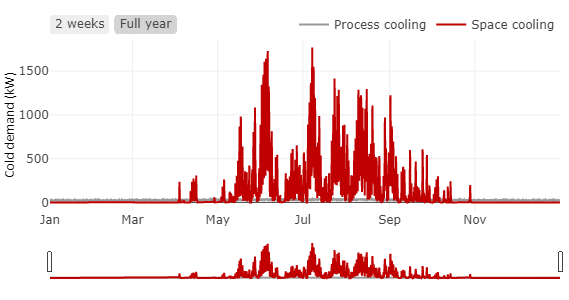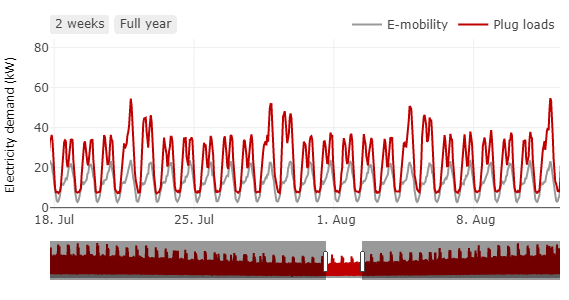nPro: Tool for generating load profiles for buildings
For the planning of districts, neighborhoods and buildings, the generation of consistent load profiles is of great importance. nPro is a tool that can be used to create consistent demand profile sets for energy demands, like space heating, domestic hot water, cooling or e-mobility.
With the help of nPro, 6 different load profile types can be created. These are:
- Space heating / heat load,
- domestic hot water,
- space cooling,
- process cooling,
- plug loads (electricity) and
- e-mobility.
Calculate load profiles for space heating
Load profiles for space heating and domestic hot water are crucial for dimensioning heating systems and heat networks. Space heating refers to the energy required to maintain a specified set point temperature in the building. Load profiles have a decisive influence on the design, since the peak loads usually determine in the capacity of the generation plants. There are different approaches of how load profiles are calculated: On the one hand, physical models can be used to represent buildings in great detail and thus calculate the physical states and energy flows quite accurately. The disadvantage of physical simulation models is that a large number of calculation parameters must be known in advance. This is usually not the case, especially in the early planning phase of districts and buildings. In addition to physical models, statistical methods can also be used. These are employed in the nPro tool, for example.
Create load profiles for domestic hot water demands
Domestic hot water is another important type of energy demand in buildings. The demand for domestic hot water will become more and more important in the future, as the building standards are constantly improving, thus reducing the demand for space heating in the building. Since, at the same time, domestic hot water demands remain more or less constant (or have increased slightly over the past decades), the relative share of domestic hot water demands in the total heat demand is steadily increasing. In residential buildings with a high insulation standard, the demand for domestic hot water can therefore already account for more than half of the total heat demand. The heat demand for domestic hot water has been surveyed for many building types. For residential buildings in particular, it is easy to calculate using approximation formulas. It should be noted, however, that the useful heat demands given are not equal to the heat demands that have to be provided by the heat generation units. In single-family houses, depending on the heating system (e.g., with or without circulation pipe), only about 50 % of the heat demand is accounted for by the actual useful heat demand at the tapping point; the other 50 % is accounted for by the distribution losses of the pipes.

Demand profiles for room air conditioning and process cooling
For cooling, two types of energy demand can be distinguished: The cooling demand for air conditioning of rooms (space cooling) and process cooling (in commercial buildings such as supermarkets). For both types of demand, only insufficient statistical evaluations are available, which is why the demand can only be roughly estimated. This is also due to the fact that room air conditioning in buildings has so far only rarely played a role and often remained unconsidered. However, the steadily increasing comfort requirements as well as the efficient supply possibilities (heat pump and 5GDHC networks) lead to the fact that in new buildings cooling supply becomes more and more relevant. This is also a result of the already noticeable climatic changes: Heat periods in summer are becoming more extreme and more prolonged. Especially in urban areas, long heat waves are problematic for people. A similar trend is taking place in process cooling: Increasing mechanization leads to higher cooling loads especially in urban areas, for example in office buildings or in general, due to the increased installation of server rooms or data centers. The consideration of load profiles for cooling applications therefore plays an increasingly important role in the building and district energy planning.

Generate profiles for electricity (plug loads) and e-mobility
Two types of electricity demands are important: Firstly, general electrical loads (plug loads), i.e. demands arising from the use of electrical appliances such as toasters, dishwashers, computers or lighting. Secondly, electricity demand from charging points for electromobility is becoming increasingly important. These have high charging currents and pronounced power peaks and must therefore be increasingly taken into account for districts, as the share of electric cars will soon become predominant. Both types of demand can be generated with nPro using statistical approaches and standard load profiles. When generating load profiles, the total demand for plug loads and e-mobility must be estimated. Plug loads can be estimated quite easily based on national statistics for different building types. E-mobility demands, on the other hand, are more difficult to estimate, since the utilization of charging stations depends on a large number of different factors, such as specific user behavior, the building type, and ultimately also pricing models of the charging station operator.

This might also interest you
nPro software
Plan your energy system with nPro!

 English
English
 Deutsch
Deutsch


